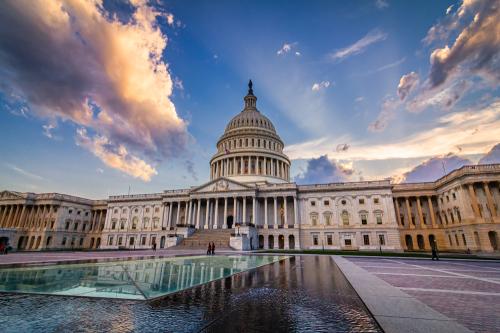The Obama administration’s financial reform proposals to be announced today are virtually all sensible, necessary reforms. Unfortunately, some bolder steps have been left out, apparently due to the expectation of intense opposition from entrenched interests. The key proposals, as described in leaked “near-final draft” form are:
- A greater focus on systemic risks
- Higher capital and liquidity requirements for financial institutions, especially the largest
- Tougher regulation of systemically important financial institutions
- Expanded “resolution authority” for regulators to take over troubled financial institutions
- Modest consolidation of regulatory functions
- New regulations for securitizations and derivatives
- Stronger consumer protections led by a new Consumer Financial Protection Agency
- Greater international coordination
Systemic regulation
Regulation has largely focused on ensuring that each financial institution was sufficiently sound in its own right with less attention paid to how the dominos could fall if a major institution fails. Banks and other financial institutions are now so interconnected that problems at one can lead to problems at others which are then magnified throughout the entire system. The level of systemic risk before this crisis was much higher than had been appreciated, spurring the government into significantly more extreme responses than one would have expected to be necessary.
There is a dual response in the proposals to the need for more systemic oversight. First, Treasury will head a new Financial Services Oversight Council (FSOC) whose role will be to identify emerging risks to the system as well as coordinating regulatory activities in general. Second, the Fed will have regulatory power over individual systemically important financial institutions of all types, as discussed later.
This dual approach appears to be a political compromise. The administration’s initial impulse was apparently to give the Fed sole authority over systemic risk regulation, both at the systemwide level and in regard to individual systemically important financial institutions. There would have been the usual consultation with its peers, but nothing like a veto power wielded by the other regulators. However, Congress is not happy with the Fed at the moment. The Fed’s role in the bailouts, especially of AIG, has annoyed many in Congress. This has magnified concerns about the huge financial power of the Fed and its dramatically expanded role in the credit markets, where it operates with little Congressional oversight.
It makes sense to have a regulator responsible for watching over risks to the system as a whole, but there is a real limit to how effective it can be because it would be asked to do something extremely difficult. Ideally, the regulator would spot problems before they spawned bubbles whose bursting would cause great economic pain afterward. However, it is not necessarily easy to spot a bubble in advance, no matter how clear it seems in retrospect. Some things which may appear to be bubbles are not, but rather reflect true long-term changes in the economy. Other trends may be bubbles, but seem as if they were not. For example, what happens if commodity prices go up further and oil reaches $100 a barrel. Is that a commodity bubble or a natural response to tight energy supplies in a recovering world economy? Bubbles almost always start as a reasonable response to changing circumstances – the problem comes when they accelerate beyond reason as investors pile in to a rising market.
The actual powers of the FSOC in practice will matter, as will its approach to using them. At one end of the spectrum, there could effectively be little more than a power to warn about danger, which could be useful, but might not make much difference. At the other end of the spectrum, there would be solid authority to force changes, perhaps by raising capital standards or even limiting certain activities outright. Ironically, the stronger the power, the harder it may be to use. Bubbles grow because there is a widespread belief in the underlying thesis driving the market and investors are profiting from following that belief. Thus, there will be strong resistance to any regulator who argues against the prevailing belief, especially if they are seen as about to destroy a profitable market opportunity that will be argued to be beneficial to society at large. For that reason, there is little risk of the opposite problem, that a systemic regulator will act too strongly or too soon, although this remains a theoretical possibility.
Despite the risks of ineffectiveness, it is better to have a regulator responsible for leaning against the wind when market forces are pushing too hard in a particular direction. Warnings and the threat of specific actions may still help rein in at least some of the excesses associated with bubbles, even if the regulatory actions themselves were to be thwarted. It would be better, however, to have a single regulator play this role rather than a council. The need to win a consensus across all the regulators, with their different views, constituencies, and institutional interests is likely to make it excessively hard to achieve the desired systemic safety.
Higher capital and liquidity requirements
The current crisis has reinforced the importance of a strong level of capital at banks and other key financial institutions. Capital represents the portion of a bank’s assets on which no one has a call except the owners of the bank, whose role is to absorb any losses. Thus, it is available to pay for mistakes and misfortunes, which we have vividly seen are a real possibility in this business. The more capital is held, the greater the level of mistakes and bad luck that can be handled.
The administration supports tougher capital requirements, which are clearly needed. The key will be finding the right balance; tough and effective without overshooting. Capital is not free, for the banks or for society. The investors who provide the capital expect a return on their investment which has to be built into the price of loans and other services or taken out of the rate paid to depositors.
Similarly, the administration supports tougher liquidity requirements, since key financial institutions have been forced to the wall because they allowed themselves to become too exposed to the risk of a “run” by creditors. Within limits, it is a useful economic function for banks to borrow short-term and lend long-term, but it needs to be carefully balanced against the risk that short-term borrowings will run off without new creditors being willing to step in at a reasonable price in a time of trouble.
Tougher regulation of systemically important financial institutions
A newly designated group of Tier 1 Financial Holding Companies (Tier 1 FHCs) would be established by the Fed, in consultation with the FSOC. These entities would be required to hold more capital and perhaps bear additional restrictions not applicable to other financial institutions. The theory is that certain financial institutions are so large or interconnected with other key market players that they cannot be allowed to fail. In practical terms, this means that there is an implicit government guarantee covering those institutions and therefore a potentially large cost to taxpayers if they begin to fail. It is reasonable to take regulatory steps to reduce the risk of failure for those institutions below the risk for less significant ones. Those restrictions may also reduce the temptation for smaller institutions to find a way to become too important to fail and thereby gain the same implicit federal guarantee. Expanded “resolution authority,” discussed next, is a key element of regulation being proposed for Tier 1 FHCs.
Expanded resolution authority
Regulators have available an elaborate set of powers to deal with banks that have fallen into trouble, powers that allow intervention well short of when a bank becomes formally insolvent. There is a regime of “prompt corrective action” steps that regulators can require banks to take once they become undercapitalized or hit other severe problems. Federal regulators have much less authority to deal with troubled financial institutions of other types, with the level of authority falling to zero for insurers or hedge funds.
The administration is proposing to give the Federal Reserve and the FDIC powers over systemically important financial institutions, including bank holding companies and Tier 1 FHCs that are not bank holding companies, that are similar to the prompt corrective action powers already enjoyed by regulators of banks. The Fed would be principally responsible for using these powers while the financial institutions remain solvent, with the FDIC taking over any institutions that actually fail.
This would be a major and controversial change to existing regulation and insolvency laws. It seems clearly necessary in regard to bank holding companies, which are standard corporations covered by regular bankruptcy rules, but which are so bound together with their bank subsidiaries as to form one integral whole. My earlier paper, “Pre-emptive Bank Nationalization Would Face Thorny Problems,” discussed some of the serious difficulties in dealing with a bank and its holding company under different legal bases.
There is also a good case for extending bank-like resolution authority to insurers, finance companies, and securities firms that are affiliated with Tier 1 FHCs, although the answer is not as clear-cut as with bank holding companies. Here the arguments for resolution authority are tied quite closely to the basic premise for tougher regulation of Tier1 FHCs in general. If we establish a separate class of Tier 1 FHCs, they will be implicitly guaranteed by the government, giving the taxpayer a greater stake in their health. We therefore need to optimize the way we deal with such entities if they become insolvent, including, preferably, establishing rules and authorities that make it less likely that they will reach insolvency. The prompt corrective action requirements on banks are a sensible way of doing this.
There are two broad arguments against extending resolution authority, as well as numerous more technical concerns. First, some analysts do not think that the separate status should be established in the first place. In part this is because it makes it more likely in their view that taxpayers will have to subsidize failures and in part because it could give an unfair competitive advantage to the largest competitors, leading them to become bigger still. Second, there are fairness issues involved in changing the insolvency regime for investors who have held bonds of the affected institutions for years under the clear understanding that they would be protected by regular bankruptcy law in the event of an insolvency.
I support extending resolution authority, but it is too complex an issue to fully discuss here. I intend to issue a separate paper in the near future expanding on the brief discussion here.
Consolidation of regulatory functions
There are significantly too many bank regulators in the United States. Different banks and bank-like institutions are regulated by: state regulators; the Office of the Comptroller of the Currency (OCC); the Federal Reserve; the Office of Thrift Supervision; the National Credit Union Administration; and, for certain important purposes, the Federal Deposit Insurance Corporation (FDIC). It appeared earlier that the administration would propose significantly reducing the number of bank regulators, perhaps to as few as a single regulator. This thought appears to have died in the face of intense opposition by many in Congress and elsewhere. No one would design the banking regulatory system the way it is now if they were starting from scratch, but there are many entrenched interests who do not want the present system to change.
The Office of Thrift Supervision is the only regulator who appears to have lacked the institutional support to retain their separate existence. The administration has proposed merging them with, and effectively into, the OCC. This move makes sense, but does not provide nearly the advantages the broader consolidation would have brought. Different regulators will inevitably have different approaches, especially as they are generally given substantial independence in order to reduce the politicization of regulatory decisions. These differing approaches can reduce the effectiveness of systemic regulation, in part by opening up the possibility of “regulatory arbitrage,” where financial groups put their various activities into the affiliates which have the softest regulatory requirements. It is true that tighter regulation of consolidated groups at the holding company level will reduce the ability to arbitrage the regulators, but it is unlikely to entail supervision as detailed as that which will occur at the level of the regulated subsidiaries.
Outside of bank regulation, there are two financial market regulators, the Securities and Exchange Commission (SEC) and the Commodities Futures Trading Commission (CFTC). It makes compelling sense to combine them, but the politics are apparently too difficult. (For one thing, the Agriculture committees of the two houses strongly wish to retain authority over a robust CFTC.) Instead, there will be additional fragmentation as some of the consumer protection functions of the SEC will overlap with that of the new consumer protection regulator discussed later.
New regulations for securitizations and derivatives
Many of the losses by financial institutions and other market players came from problems with securitizations of mortgages and other assets or from problems with derivatives, particularly credit default swaps. The administration proposes greater regulation in both areas, in line with previous statements.
The biggest change to securitizations would be a requirement that the originators of the loans underlying the securities retain at least 5% of the risk. The idea of “keeping some skin in the game” is intuitively appealing and should help. However, it is important not to take excessive comfort from this change. Banks will indeed pay more attention to the quality of the assets they securitize if they retain even a small fraction of them. But, the financial incentives in a bull market for those assets will still push them towards taking greater and greater risks, since they will immediately gain most of the benefits through securitization while only having a future risk on a small fraction of the asset pools. Also, banks are not immune to the euphoria that grips the larger markets during an asset bubble. The banks, to their regret, actually retained much of the mortgage risk from the bubble period, sometimes even buying more in the open market.
The administration is also proposing other positive steps related to securitization, including: greater transparency about the assets backing the securities; clearer guidance from the rating agencies about the differences between asset-backed securities and regular corporate debt; and changes to the compensation structure for the parties involved in securitization.
On the derivatives side, the administration had already indicated that it would push for all standardized derivatives to be traded through an organized exchange or cleared through a clearing house. An exchange is a centrally organized marketplace for the purchase and sale of financial products. The best known is probably the New York Stock Exchange, but there are also several prominent exchanges that do a major business in derivatives already. Exchanges bring a real benefit from transparency about the pricing and volume of trades, as well as making it easier for regulators to track trading positions of major parties. In contrast, much of the trading volume in derivatives now takes place “over the counter,” between two counterparties who are not generally required to report details of the trade and who take each other’s credit risk in regard to the transaction. This credit risk is often mitigated by requiring collateral, but it is clear in retrospect that this process was not well-managed in many cases, leaving a large number of institutions very exposed to the credit risk of AIG, for example.
The major exchanges dealing in derivatives use central clearing houses that act as the counterparty to both sides. If A sells an option to B on the exchange, the clearing house would interpose itself, buying from A and selling the option on to B. The sole purpose of this interposition is to eliminate B’s credit exposure to A. If the option becomes valuable over time, B needs A to make good on its promise. If A doesn’t, the clearing house would make good, protecting B. Such clearing houses can also handle trades that were done off of an exchange, which will be an allowed alternative in certain cases.
It should be noted that using a clearing house does not eliminate counterparty risk altogether. The clearing house could become insolvent itself if enough of its counterparties fail to meet their obligations. This should still represent a diminution of the total credit risk in the system, since clearing houses are well-capitalized and operate in a clearly defined business that is easier to manage than a broader business, but there could be extreme circumstances where a government rescue would be required.
The big controversy with derivatives is what to do about customized derivatives. The use of derivatives to manage risk by sophisticated corporations is pervasive. Sometimes those derivatives are significantly cheaper or more effective if they cover the exact risk rather than using one or more standard derivatives to approximate the desired protection. It would be a great shame to lose those efficiencies altogether by banishing customized derivatives, but there is also a fear that financial firms will deliberately sell slightly non-standard derivatives in order to avoid the tougher rules on standardized ones.
This is another area where the devil is in the details. The trick will be to provide incentives or requirements to use standard derivatives where possible, while leaving the ability to use customized ones where they serve a genuine need. The administration’s proposal attempts to strike this balance. It will be interesting to see what comes out the other end of the legislative process, given the combination of a high degree of public anxiety about derivatives combined with a lack of understanding of this complex topic by many who are voicing opinions about the proper course of action.
Stronger consumer protections
The administration has proposed creating a Consumer Financial Protection Agency (CFPA), responsible for all aspects of regulation of mortgages, credit cards, and other consumer-focused financial products, with a few exceptions, such as mutual funds, which are left with the SEC. This appears to be a fairly powerful agency, with the power to set binding regulations, impose fines, etc. It will specifically be authorized to impose an obligation to offer “plain vanilla” products, such as a standardized 30-year fixed rate mortgage, with the possibility that consumers who wish to make another choice will have to specifically waive their right to have the standardized product.
There have been many bad practices that developed in the bubble period which harmed consumers, especially related to sub-prime mortgages. It will be useful to have a clear regulatory focus on eliminating those problems and avoiding others in the future. The critical issue will be the extent to which the CFPA is able to find the right balance between promoting consumer safety and allowing innovation. Everyone can agree on the need for transparency. What is harder is when there are both risks and rewards to a given product, from the consumer’s viewpoint. How much will the CFPA try to protect consumers from taking risks that might actually be legitimate in light of the potential rewards?
Another key issue that will be determined by a combination of legislative wording and regulatory choices over time is the extent to which the CFPA will move out of products that are clearly consumer products into a wider range of financial products. For example, would the CFPA ever find itself imposing regulations on derivative products, perhaps on the basis that some individuals do invest in them? This appears not to be the intent of the proposal, but there will doubtless be gray areas in practice.
Greater international coordination
Finally, the administration has also highlighted the need for greater international regulatory cooperation. This would indeed be useful, particularly if the United States develops tougher rules in some areas than currently exist elsewhere. However, it is not likely that there will be a large effect on U.S. policy from this international cooperation. As has already been seen with the failure to propose significant regulatory consolidation, financial regulation in the United States is a very parochial affair, with entrenched interests fighting their corner with relatively little regard for what is going on in the rest of the world.
Summary
The proposals are generally quite sensible. The unfortunate aspect is that political constraints have caused the administration to stop short of a full solution in certain areas, most notably in the consolidation of regulatory functions into fewer hands. Nonetheless, the country should be better off if these proposals are passed than if we were to remain as we are now.
The Brookings Institution is committed to quality, independence, and impact.
We are supported by a diverse array of funders. In line with our values and policies, each Brookings publication represents the sole views of its author(s).



